What three things prompted the gospels to be written down
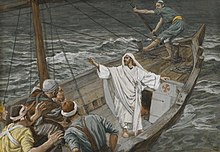
The gospels of Matthew, Marker, and Luke are referred to as the synoptic Gospels because they include many of the same stories, often in a similar sequence and in similar or sometimes identical diction. They stand in contrast to John, whose content is largely distinct. The term synoptic (Latin: synopticus; Greek: συνοπτικός, romanized: synoptikós ) comes via Latin from the Greek σύνοψις , synopsis, i.east. "(a) seeing all together, synopsis";[n 1] the sense of the discussion in English, the one specifically applied to these three gospels, of "giving an account of the events from the same signal of view or under the same full general aspect" is a modernistic one.[i]
This strong parallelism among the three gospels in content, arrangement, and specific language is widely attributed to literary interdependence.[2] The question of the precise nature of their literary relationship—the synoptic problem—has been a topic of lively debate for centuries and has been described as "the virtually fascinating literary enigma of all time".[3] While no conclusive solution has been found yet, the longstanding majority view favors Marcan priority, in which both Matthew and Luke have made direct utilize of the Gospel of Mark every bit a source, and further holds that Matthew and Luke as well drew from an additional hypothetical document, chosen Q.[4]
Structure [edit]

Over three-quarters of Marking's content is found in both Matthew and Luke, and 97% of Mark is found in at least i of the other 2 synoptic gospels. Additionally, Matthew (44%) and Luke (58%) take material in mutual that is not found in Marking.[5]
Common features [edit]
Broadly speaking, the synoptic gospels are like to John: all are composed in Koine Greek, have a similar length, and were completed within a century of Jesus' expiry. They also differ from non-approved sources, such as the Gospel of Thomas, in that they belong to the ancient genre of biography,[6] [7] collecting not only Jesus' teachings, but recounting in an orderly style his origins, his ministry and miracles, and his passion and resurrection.
In content and in wording, though, the synoptics diverge widely from John but have a cracking bargain in common with each other. Though each gospel includes some unique fabric, the majority of Marker and roughly half of Matthew and Luke coincide in content, in much the aforementioned sequence, oftentimes nearly verbatim. This common fabric is termed the triple tradition.
The triple tradition [edit]
The triple tradition, the material included by all three synoptic gospels, includes many stories and teachings:
- John the Baptist
- Baptism and temptation of Jesus
- First disciples of Jesus
- Hometown rejection of Jesus
- Healing of Peter's mother in law, demoniacs, a leper, and a paralytic
- Telephone call of the taxation collector
- New Vino into Old Wineskins
- Man with withered hand
- Commissioning the Twelve Apostles
- The Beelzebul controversy
- Teachings on the parable of the strong man, eternal sin, His true relatives, the parable of the sower, the lamp nether a bushel, and the parable of the mustard seed
- Calming the storm
- The Gerasene demoniac
- The girl of Jairus and the bleeding woman
- Feeding the 5000
- Confession of Peter
- Transfiguration
- The demoniac male child
- The little children
- The rich fellow
- Jesus predicts his decease
- Bullheaded near Jericho
- Palm Sunday
- Casting out the money changers
- Render unto Caesar
- Woes of the Pharisees
- Second Coming Prophecy
- The Last Supper, passion, crucifixion, and entombment
- The empty tomb and resurrected Jesus
- Nifty Commission
The triple tradition's pericopae (passages) tend to be bundled in much the same order in all three gospels. This stands in contrast to the material institute in only two of the gospels, which is much more variable in society.[8] [9]
The classification of text equally belonging to the triple tradition (or for that matter, double tradition) is not always definitive, depending rather on the degree of similarity demanded. Matthew and Marker report the cursing of the fig tree[Mt 21:18–22] [Mk 11:12–24], a single incident, despite some substantial differences of wording and content. In Luke, the just parable of the barren fig tree[Lk thirteen:6–9], is in a different point of the narrative. Some would say that Luke has extensively adapted an element of the triple tradition, while others would regard information technology as a distinct pericope.
Case [edit]

Christ cleansing a leper by Jean-Marie Melchior Doze, 1864.
An illustrative example of the three texts in parallel is the healing of the leper:[10]
| Mt 8:2–3 | Mk one:40–42 | Lk five:12–13 |
|---|---|---|
| Καὶ ἰδοὺ, ἐκαθαρίσθη | Καὶ ἔρχεται πρὸς αὐτὸν | Καὶ ἰδοὺ, ἡ λέπρα ἀπῆλθεν ἀπ᾿ |
| And behold, and worships him, saying: And he stretched out his was cleansed. | And, calling out to him, and kneeling and saying to him: | And behold, And he stretched out his |
More than one-half the wording in this passage is identical. Each gospel includes words absent in the other two and omits something included by the other ii.
Relation to Mark [edit]
The triple tradition itself constitutes a consummate gospel quite like to the shortest gospel, Mark.[viii]
Marking, dissimilar Matthew and Luke, adds little to the triple tradition. Pericopae unique to Mark are deficient, notably 2 healings involving saliva[Mk vii:33–36; 8:22–26] and the naked runaway.[Mk 14:51–52] Marker's additions inside the triple tradition tend to be explanatory elaborations (e.g., "the rock was rolled dorsum, for it was very large " [Mk 16:4]) or Aramaisms (e.g., "Talitha kum!"[Mk five:41]). The pericopae Mark shares with but Luke are too quite few: the Capernaum exorcism[Mk 1:23–28] [Lk 4:33–37] and deviation from Capernaum,[Mk i:35–38] [Lk iv:42–43] the strange exorcist,[Mk 9:38–41] [Lk 9:49–fifty] and the widow's mites.[Mk 12:41–44] [Lk 21:1–four] A greater number, simply all the same not many, are shared with only Matthew, most notably the so-called "Cracking Omission"[11] from Luke of Mk six:45–eight:26.
Well-nigh scholars take these observations equally a strong clue to the literary relationship among the synoptics and Marker's special identify in that relationship.[12] The hypothesis favored by most experts is Marcan priority, whereby Mark was equanimous commencement, and Matthew and Luke each used Mark, incorporating much of it, with adaptations, into their own gospels. A leading alternative hypothesis is Marcan posteriority, with Mark having been formed primarily by extracting what Matthew and Luke shared in common.[13]
The double tradition [edit]

The preaching of John the Baptist in Matthew and Luke, with differences rendered in black.[fourteen] Hither the ii texts agree verbatim, with an isolated exception, for a span of over sixty words. Marking has no parallel.
An extensive fix of cloth—some 2 hundred verses, or roughly one-half the length of the triple tradition—are the pericopae shared betwixt Matthew and Luke, but absent in Marking. This is termed the double tradition.[15] Parables and other sayings predominate in the double tradition, but also included are narrative elements:[xvi]
- Preaching of John the Baptist
- Temptation of Jesus (which Mark summarizes in two verses)
- The Sermon on the Mount (Matthew) or Evidently (Luke)
- The Centurion's servant
- Messengers from John the Baptist
- Woes to the unrepentant cities
- Jesus cheers his Male parent
- Render of the unclean spirit
- Parables of the leaven, the lost sheep, the cracking banquet, the talents, and the faithful retainer
- Discourse against the scribes and Pharisees
- Lament over Jerusalem
Unlike triple-tradition cloth, double-tradition cloth is structured differently in the two gospels. Matthew's lengthy Sermon on the Mount, for example, is paralleled past Luke's shorter Sermon on the Manifestly, with the residuum of its content scattered throughout Luke. This is consistent with the general pattern of Matthew collecting sayings into big blocks, while Luke does the contrary and intersperses them with narrative.[17]
Besides the double tradition proper, Matthew and Luke often agree confronting Mark inside the triple tradition to varying extents, sometimes including several additional verses, sometimes differing by a single give-and-take. These are termed the major and small-scale agreements (the distinction is imprecise[18] [19]). One example is in the passion narrative, where Marker has simply, "Prophesy!"[Mk fourteen:65] while Matthew and Luke both add, "Who is information technology that struck you lot?"[Mt 26:68] [Lk 22:64] [twenty]
The double tradition's origin, with its major and minor agreements, is a key facet of the synoptic problem. The simplest hypothesis is Luke relied on Matthew'south work or vice versa. But many experts, on various grounds, maintain that neither Matthew nor Luke used the other'southward work. If this is the case, they must have drawn from some common source, singled-out from Marking, that provided the double-tradition material and overlapped with Mark's content where major agreements occur. This hypothetical certificate is termed Q, for the German Quelle, meaning "source".[21]
Special Matthew and Special Luke [edit]
Matthew and Luke contain a large amount of textile found in no other gospel. These materials are sometimes called Special Matthew or 1000 and Special Luke or L.
Both Special Matthew and Special Luke include distinct opening infancy narratives and post-resurrection conclusions (with Luke standing the story in his 2d volume Acts). In between, Special Matthew includes more often than not parables, while Special Luke includes both parables and healings.
Special Luke is notable for containing a greater concentration of Semitisms than any other gospel textile.[22]
Luke gives some indication of how he composed his gospel in his prologue:[23] [24]
Since many have undertaken to set down an orderly account of the events that have been fulfilled amid us, just equally they were handed on to united states by those who from the beginning were eyewitnesses and servants of the give-and-take, I too decided, after investigating everything carefully from the very first, to write an orderly business relationship for you, most fantabulous Theophilus, so that y'all may know the truth concerning the things virtually which you have been instructed.[Lk 1:ane–4 (NRSV)]
Synoptic trouble [edit]
The "synoptic problem" is the question of the specific literary relationship amid the three synoptic gospels—that is, the question as to the source or sources upon which each synoptic gospel depended when it was written.
The texts of the three synoptic gospels oft agree very closely in wording and society, both in quotations and in narration. Most scholars accredit this to documentary dependence, straight or indirect, meaning the close agreements amidst synoptic gospels are due to one gospel's drawing from the text of another, or from some written source that another gospel also drew from.[25]
Controversies [edit]
The synoptic problem hinges on several interrelated points of controversy:
- Priority: Which gospel was written first? (If ane text draws from some other, the source must take been composed first.)
- Successive dependence: Did each of the synoptic gospels depict from each of its predecessors? (If non, the frequent agreements between the two independent gospels confronting the third must originate elsewhere.)
- Lost written sources: Did whatever of the gospels describe from some earlier document which has not been preserved (e.one thousand., the hypothetical "Q", or from earlier editions of other gospels)?
- Oral sources: To what extent did each evangelist or literary collaborator[26] draw from personal knowledge, eyewitness accounts, liturgy, or other oral traditions to produce an original written account?
- Translation: Jesus and others quoted in the gospels spoke primarily in Aramaic, but the gospels themselves in their oldest available form are each written in Koine Greek. Who performed the translations, and at what point?
- Redaction: How and why did those who put the gospels into their terminal form expand, abridge, modify, or rearrange their sources?
Some[ which? ] theories try to explain the relation of the synoptic gospels to John; to non-canonical gospels such as Thomas, Peter, and Egerton; to the Didache; and to lost documents such equally the Hebrew logia mentioned by Papias, the Jewish–Christian gospels, and the Gospel of Marcion.
History [edit]

A page of Griesbach's Synopsis Evangeliorum, which presents the texts of the synoptic gospels arranged in columns.
Ancient sources virtually unanimously ascribe the synoptic gospels to the campaigner Matthew, to Peter's interpreter Marking, and to Paul'southward companion Luke—hence their respective canonical names.[27] The ancient authors, however, did not agree on which order the Gospels had been written. For example, Clement of Alexandria held that Matthew wrote first, Luke wrote second and Mark wrote third;[28] on the other hand, Origen argued that Matthew wrote outset, Mark wrote 2nd and Luke wrote third;[29] finally, Tertullian states that John and Matthew were published outset and that Mark and Luke came later.[30] [31]
A remark by Augustine of Hippo at the beginning of the fifth century presents the gospels as composed in their canonical lodge (Matthew, Mark, Luke, John), with each evangelist thoughtfully building upon and supplementing the work of his predecessors—the Augustinian hypothesis (Matthew–Mark).[32]
This view (when whatever model of dependence was considered at all) seldom came into question until the late eighteenth century, when Johann Jakob Griesbach published in 1776 a synopsis of the synoptic gospels. Instead of harmonizing them, he displayed their texts side by side, making both similarities and divergences apparent. Griesbach, noticing the special place of Mark in the synopsis, hypothesized Marcan posteriority and advanced (every bit Henry Owen had a few years before[33]) the ii-gospel hypothesis (Matthew–Luke).
In the nineteenth century, researchers practical the tools of literary criticism to the synoptic problem in earnest, especially in High german scholarship. Early work revolved around a hypothetical proto-gospel (Ur-Gospel), possibly in Aramaic, underlying the synoptics. From this line of inquiry, however, a consensus emerged that Marking itself served as the principal source for the other two gospels—Marcan priority.
In a theory first proposed by Christian Hermann Weisse in 1838, the double tradition was explained past Matthew and Luke independently using two sources—thus, the two-source (Marking–Q) theory—which supplemented Mark with another hypothetical source consisting more often than not of sayings. This additional source was at commencement seen equally the logia (sayings) spoken of past Papias and thus called "Λ", only afterwards information technology became more generally known as "Q", from the German Quelle, meaning source.[34] This two-source theory eventually won wide acceptance and was seldom questioned until the late twentieth century; most scholars just took this new orthodoxy for granted and directed their efforts toward Q itself, and this is still[update] largely the case.[ citation needed ]
The theory is as well well known in a more elaborate form set forth by Burnett Hillman Streeter in 1924, which additionally hypothesized written sources "M" and "L" (for "Special Matthew" and "Special Luke" respectively)—hence the influential 4-certificate hypothesis. This exemplifies the prevailing scholarship of the fourth dimension, which saw the canonical gospels as tardily products, dating from well into the second century, composed past unsophisticated cut-and-paste redactors out of a progression of written sources, and derived in plough from oral traditions and from folklore that had evolved in diverse communities.[35] More recently,[ when? ] all the same, every bit this view has gradually fallen into disfavor, so as well has the centrality of documentary interdependence and hypothetical documentary sources as an caption for all aspects of the synoptic problem.[ citation needed ]
In recent decades, weaknesses of the two-source theory have been more widely recognized,[ past whom? ] and fence has reignited. Many have independently argued that Luke did brand some use of Matthew later all—the Common Sayings Source. British scholars went further and dispensed with Q entirely, ascribing the double tradition to Luke's directly utilize of Matthew—the Farrer hypothesis of 1955.[36] New attention is also beingness given[ by whom? ] to the Wilke hypothesis of 1838 which, like Farrer, dispenses with Q only ascribes the double tradition to Matthew's direct utilize of Luke. Meanwhile, the Augustinian hypothesis has also made a comeback, especially in American scholarship. The Jerusalem schoolhouse hypothesis has as well attracted fresh advocates, as has the Independence hypothesis, which denies documentary relationships altogether.[ citation needed ]
On this plummet of consensus, Wenham observed: "I institute myself in the Synoptic Problem Seminar of the Gild for New Attestation Studies, whose members were in disagreement over every aspect of the bailiwick. When this international group disbanded in 1982 they had sadly to confess that after twelve years' work they had not reached a common mind on a single issue."[37]
More recently, Andris Abakuks practical a statistical time series approach to the Greek texts to determine the relative likelihood of these proposals. Models without Q fit reasonably well. Matthew and Luke were statistically dependent on their borrowings from Marking. This suggests at to the lowest degree one of Matthew and Luke had access to the other'due south work. The virtually likely synoptic gospel to be the last was Luke. The least probable was Mark. While this weighs against the Griesbach proposal and favors the Farrer, he does not claim whatever proposals are ruled out.[38]
Conclusions [edit]
No definitive solution to the Synoptic Problem has been found yet. The Two-source hypothesis, which was dominant throughout the 20th century, all the same enjoys the support of most New Testament scholars; however, information technology has come up under substantial assault in recent years past a number of biblical scholars, who have attempted to relaunch the Augustinian hypothesis,[39] the Griesbach hypothesis[twoscore] and the Farrer hypothesis.[41]
In detail, the being of the Q source has received harsh criticism in the first two decades of the 21st century: scholars such as Mark Goodacre and Brant Pitre have pointed out that no manuscript of Q has ever been found, nor is any reference to Q e'er made in the writings of the Church Fathers (or whatsoever ancient writings, in fact).[42] [43] [44] This has prompted East. P. Sanders and Margaret Davies to write that the Two-sources hypothesis, while still dominant, "is least satisfactory"[45] and Joseph Fitzmyer to state that the Synoptic Problem is "practically insoluble".[46]
Theories [edit]
Nigh every conceivable theory has been advanced every bit a solution to the synoptic problem.[47] The almost notable theories include:
| Priority | Theory[48] | Diagram | Notes |
|---|---|---|---|
| Marcan priority | 2‑source (Mark–Q) |  | Most widely accepted theory. Matthew and Luke independently used Q, taken to be a Greek certificate with sayings and narrative. |
| Farrer (Marking–Matthew) |  | Double tradition explained entirely by Luke'southward apply of Matthew. | |
| Three‑source (Marking–Q/Matthew) |  | A hybrid of Two-source and Farrer. Q may be express to sayings, may be in Aramaic, and may too be a source for Mark. | |
| Wilke (Mark–Luke) | 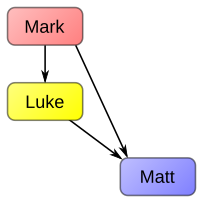 | Double tradition explained entirely by Matthew'due south employ of Luke. | |
| Four-source (Mark–Q/M/L) | 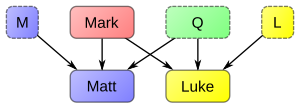 | Matthew and Luke used Q. Simply Matthew used M and simply Luke used L. | |
| Matthaean priority | Two‑gospel (Griesbach) (Matthew–Luke) |  | Marking primarily has nerveless what Matthew and Luke share in mutual (Marcan posteriority). |
| Augustinian (Matthew–Marking) |  | The oldest known view, still advocated by some. Mark'southward special place is neither priority nor posteriority, merely as the intermediate betwixt the other 2 synoptic gospels. Approved order is based on this view having been assumed (at the time when New Testament Canon was finalized). | |
| Lucan priority | Jerusalem school (Luke–Q) |  | A Greek anthology (A), translated literally from a Hebrew original, was used past each gospel. Luke likewise drew from an earlier lost gospel, a reconstruction (R) of the life of Jesus reconciling the anthology with yet another narrative work. Matthew has not used Luke direct. |
| Marcion priority | Marcion hypothesis |  | All gospels directly used the gospel of Marcion equally their source, and have been influenced heavily by it. |
| Others or none | Multi‑source | 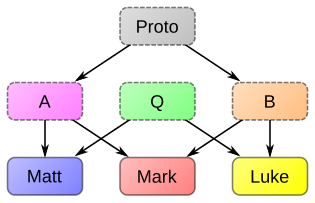 | Each gospel drew from a different combination of hypothetical before documents. |
| Proto‑gospel |  | The gospels each independently derive from a mutual proto-gospel (Ur-Gospel), possibly in Hebrew or Aramaic. | |
| Q+/Papias (Mark–Q/Matthew) | 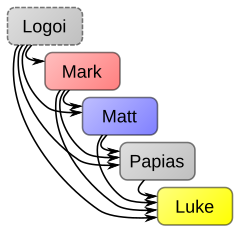 | Each document drew from each of its predecessors, including Logoi (Q+) and Papias' Exposition. | |
| Independence |  | Each gospel is an independent and original limerick based upon oral history. |
See too [edit]
- Aramaic primacy
- Authorship of the Gospels
- Biblical criticism
- Gospel harmony
- List of Gospels
- List of cardinal episodes in the Canonical Gospels
- Source criticism
Notes [edit]
- ^ Both Greek words, synoptikos and synopsis, derive from σύν syn (prep.), meaning "together, with", and etymologically related words pertaining to sight, vision, appearance, i.e. ὀπτικός optikos (adj.; cf. English optic), pregnant "of or for sight", and ὄψις opsis (n.), meaning "advent, sight, vision, view".[ane]
References [edit]
- ^ a b "synoptic". Oxford English Dictionary (Online ed.). Oxford University Press. (Subscription or participating institution membership required.) Harper, Douglas. "synoptic". Online Etymology Dictionary. Harper, Douglas. "synopsis". Online Etymology Dictionary. Harper, Douglas. "optic". Online Etymology Dictionary. σύν , ὄπτός , ὀπτικός , ὄψις , συνοπτικός , σύνοψις . Liddell, Henry George; Scott, Robert; A Greek–English Lexicon at the Perseus Project.
- ^ Goodacre, Mark (2001). The Synoptic Problem: A Way Through the Maze. p. 16. ISBN0567080560.
- ^ Goodacre (2001), p. 32.
- ^ Goodacre (2001), pp. xx–21.
- ^ Honoré, A. M. (1968). "A Statistical Study of the Synoptic Problem". Novum Testamentum. 10 (2/3): 95–147. doi:10.2307/1560364. ISSN 0048-1009. JSTOR 1560364.
- ^ Bauckham, Richard (2006). Jesus and the Eyewitnesses: The Gospels as Eyewitness Testimony . p. 220. ISBN0802831621.
- ^ Perkins, Pheme (2009). Introduction to the Synoptic Gospels. pp. 2–11. ISBN978-0802865533.
- ^ a b Goodacre (2001), p. 38.
- ^ Neville, David (2002). Mark'south Gospel – Prior Or Posterior?: A Reappraisal of the Phenomenon of Social club. ISBN1841272655.
- ^ Smith, Ben C. (2009). "The healing of a leper". TextExcavation . Retrieved 2013-11-24 .
- ^ Stein, Robert H. (1992). Luke: An Exegetical and Theological Exposition of Holy Scripture. pp. 29–xxx. ISBN0805401245.
- ^ Kloppenborg, John S. (2000). Excavating Q: The History and Setting of the Sayings Gospel. pp. twenty–28. ISBN1451411553.
- ^ Goodacre (2001), p. 81.
- ^ Mt three:vii–10 & Lk 3:7–9. Text from 1894 Scrivener New Testament.
- ^ Goodacre (2001), pp. 39 ff.
- ^ Goodacre (2001), pp. forty–41, 151–52.
- ^ Goodacre (2001), pp. 124–26.
- ^ Goodacre (2001), pp. 148–51.
- ^ Goodacre, Marker (2007-eleven-xiv). "Mark-Q Overlaps 4: Back to the Continuum". NT Web log . Retrieved 2013-xi-24 .
- ^ Goodacre (2001), pp. 145–46.
- ^ Goodacre (2001), p. 108.
- ^ Edwards, James R. (2009). The Hebrew Gospel and the Development of the Synoptic Tradition. pp. 141–48. ISBN978-0802862341.
- ^ Bauckham (2006), pp. 65–66.
- ^ Alexander, Loveday (2005). The Preface to Luke's Gospel. ISBN0521018811.
- ^ Goodacre, Mark (2013). "Synoptic Problem". In McKenzie, Steven L. (ed.). Oxford Encyclopedia of Biblical Interpretation. Oxford University Press. ISBN9780199832262.
- ^ Compare: Watts, John (1860). Who Were the Writers of the New Testament?: The "evidence" Shown to be Untrustworthy Both as to the Time and Authors of the Several Gospels. London: George Abington. p. nine. Retrieved 29 May 2020.
Hennell, in his 'Origin of Christianity,' says that:- 'Some i after Matthew wrote the Greek Gospel which has come down to u.s., incorporating part of the Hebrew 1, whence it was called the Gospel co-ordinate to Matthew, and, in the second century, came to be considered as the work of the Apostle.'
- ^ Hengel, Martin (2000). The four Gospels and the i Gospel of Jesus Christ: an investigation of the collection and origin of the Approved Gospels. pp. 34–115. ISBN1563383004.
- ^ Eusebius, Church History, Volume 6, Affiliate 14, Paragraphs half dozen-x
- ^ Eusebius, Church History, Book 6, Chapter 25, Paragraphs iii-six
- ^ Tertullian, Against Marcion, Book 4, Chapter 5
- ^ Pitre, Brant (2016-02-02). The Instance for Jesus: The Biblical and Historical Show for Christ. Crown Publishing Group. pp. 95–96. ISBN978-0-7704-3549-3.
- ^ Dungan, David L. (1999). A history of the synoptic problem: the canon, the text, the composition and the interpretation of the Gospels. pp. 112–44. ISBN0385471920.
- ^ Owen, Henry (1764). Observations on the 4 Gospels, tending chiefly to ascertain the time of their Publication, and to illustrate the form and manner of their Composition. London: T. Payne. Retrieved 2018-ten-13 .
- ^ Lührmann, Dieter (1995). "Q: Sayings of Jesus or Logia?". In Piper, Ronald Allen (ed.). The Gospel Behind the Gospels: Electric current Studies on Q. pp. 97–102. ISBN9004097376.
- ^ Goodacre (2001), pp. 160–61.
- ^ Farrer, A. K. (1955). "On Dispensing With Q". In Nineham, D. E. (ed.). Studies in the Gospels: Essays in Memory of R. H. Lightfoot. Oxford: Blackwell. pp. 55–88. Retrieved 2018-10-thirteen .
The literary history of the Gospels volition turn out to be a simpler matter than nosotros had supposed. St. Matthew volition be seen to be an amplified version of St. Marker, based on a decade of habitual preaching, and incorporating oral material, just presupposing no other literary source beside St. Marking himself. St. Luke, in turn, will be plant to presuppose St. Matthew and St. Marker, and St. John to presuppose the three others. The whole literary history of the canonical Gospel tradition will be establish to exist contained in the fourfold catechism itself, except in so far every bit it lies in the Old Testament, the Pseudepigrapha, and the other New Attestation writings. [...] Once rid of Q, nosotros are rid of a progeny of nameless chimaeras, and gratis to let St. Matthew write as he is moved.
- ^ Wenham, John (1992). Redating Matthew, Mark, & Luke. p. xxi. ISBN0830817603.
- ^ Abakuks, Andris (2014). The Synoptic Problem and Statistics (1 ed.). Chapman and Hall/CRC. ISBN978-1466572010.
- ^ Wenham, John (1992). Redating Matthew, Mark and Luke: A Fresh Assault on the Synoptic Problem. Wipf and Stock Publishers. ISBN978-1-7252-7664-2.
- ^ Black, David Alan (2010). Why Four Gospels?. Energion Publications. ISBN978-1-63199-250-6.
- ^ Poirier, John C.; Peterson, Jeffrey (2015). Marcan Priority Without Q: Explorations in the Farrer Hypothesis. Bloomsbury Publishing. ISBN978-0-567-36756-3.
- ^ Goodacre, Mark (2002-02-01). The Example Against Q: Studies in Markan Priority and the Synoptic Trouble. A&C Black. ISBN978-1-56338-334-two.
- ^ Goodacre, Mark S.; Perrin, Nicholas (2004). Questioning Q: A Multidimensional Critique. InterVarsity Printing. ISBN978-0-281-05613-2.
- ^ Pitre, Brant (2016-02-02). The Case for Jesus: The Biblical and Historical Evidence for Christ. Crown Publishing Group. p. 97. ISBN978-0-7704-3549-3.
- ^ Sanders, Eastward. P.; Davies, Margaret (1989). Studying the Synoptic Gospels. SCM Press. p. 117. ISBN978-0-334-02342-5.
- ^ Buttrick, David One thousand. (1970). Jesus and Man's Promise. Pittsburgh: Pittsburgh Theological Seminary. p. 132.
- ^ Carlson (September 2004). "Synoptic Problem". Hypotyposeis.org. Carlson lists over twenty of the major ones, with citations of the literature.
- ^ Though eponymous and some haphazard structural names are prevalent in the literature, a systematic structural nomenclature is advocated by Carlson and Smith, and these names are also provided. The exception is the Marcion hypothesis which is not part of their nomenclatures.
External links [edit]
- Catholic Encyclopedia: Synoptics
- Hypotyposeis: Synoptic Trouble Website
- Synoptic Trouble: Bibliography of the main studies in English language
- TextExcavation: The Synoptic Project
- Synoptic Gospels Primer
- NT Gateway: Synoptic Problem Web Sites
- The Synoptic Problem and its Solution
- Matthew Conflator (Wilke) Hypothesis
- Synoptic Hypotheses and Authors
Source: https://en.wikipedia.org/wiki/Synoptic_Gospels
0 Response to "What three things prompted the gospels to be written down"
Post a Comment